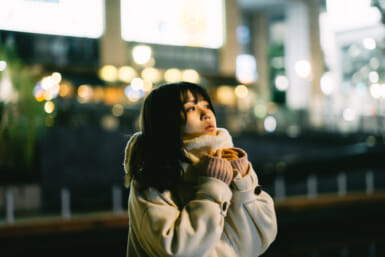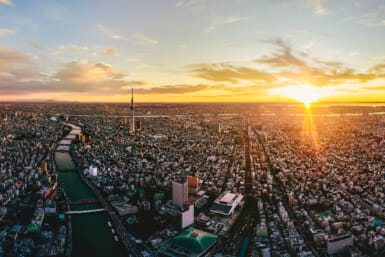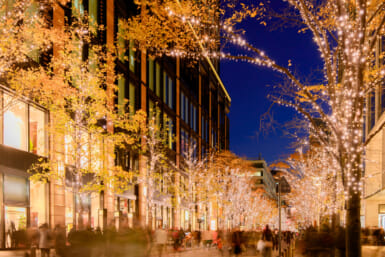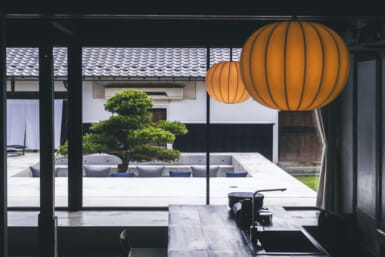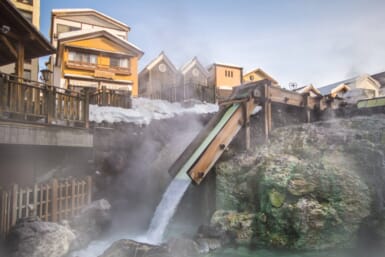by Peter Neill
A discouraging characteristic of the vertical city is the loss of neighborhood. As cities developed in America, as density increased primarily in the form of apartment towers displacing private residence, so did the city dweller’s sense of anonymity expand, to the point now where so often the family across the hall exists only as muffled sound behind an impersonal door and the person across the street is a total stranger.
Lesser developed cities in Europe and Asia, then, retain still that neighborhood identity the loss of which Americans mourn. Only recently has Tokyo begun to show vertical orientation, the Kasumigaseki Building and the Shinjuku Plaza development, for example, and ine apartment mansions” of Azabu, where many foreign residents live in splendid isolation above the city around them.
Thus while Tokyo’s density is fur greater than most, while the city manifests unsightly sprawl, it is comprised of hundreds of parts each having a unique appearance and feeling, distinctions which are understood by the citizens of the city as a whole, and which give each person living within the area a particular and shared identity: “neighborgoods,” again my young son’s word, but descriptive.
This is not to say that Tokyo is constant back fence chatter and block parties – absolutely not. Quite formal relationships exist between immediate neighbors. Nevertheless, certain social services are shared daily. Every “Neighborgood” has its own temple, vegetable and fish market, butcher, variety of small bars and eating places, playground, public bath, and police box, spaces of communal use in which familiarity and empathy, otherwise inhibited by circumstance or the rigid Japanese social structure, thrive. In the “neighborhood,” all are equal before whichever deity, the law, the fishwife, and each other in the bath.
Pick up the telephone in Tokyo and, within minutes, most anything can be delivered to your door. A bowl of noodles strikes your fancy, simply call and bring the delivery boy on his bike, careening though the traffic, precarious tray piled with dishes. Tempura, Sushi, a full-course meal, most neighborhood restaurants deliver without question or charge.
So, too, do many of the city’s merchants, those ubiquitous putt-putt vans bringing the department store, dry cleaners and launderers, local grocers, beer and sake merchant, iceman, milkman, newsboy ad hominem to your door. Utility bills are paid to the bowing gentleman, moving door-to-door with his pouchful of change. The bookseller drops by my new, and bulky, dictionary. A girl selling fresh cut flowers comes every Thursday, Tuesday the old lady swapping dust rags.
It seems preposterous, otherworldly arid wasteful, all this convenience and service, most especially to the city person accustomed to rudeness and indifference, to the genetic impossibility of a smile much less a helping hand, to dashing out on a rainy evening for leaky Chinese take-out or a soggy circle of dough, tomato, and cheese, touched with an inelegant afterthought of the pepperoni. It seems far too civilized; civilization, it is understood, no longer being a viable attribute of cities.
And should true evil threaten your threshold, an insurance man or worse, dial-a-hero, call in the Ultraforce, the Tokyo police.
The sun was up and throwing crisp shadows, the neighbors sipped morning tea in their small garden across from my house. Our laundry line was hung with the usual: a few diapers, a shirt, some underwear, in particular, a pair of woman’s panties provocatively decorated with a “mixed fruit” pattern.
Yet this tranquility was disrupted by a presence inexorably drawn to that laundry line, driven by Destiny to creep in through the gate, to grab the mixed fruit and run. The neighbor gave chase but was outdistanced.
What to do? The neighbor’s wife explained she had lost some expensive Italian foundation work only the week before. A pity, but ours was knee-jerk resignation to the loss. Call the police? Can you imagine the reaction of a New York precinct sergeant to the outraged report of panty loss?
Time passed. A delegation appeared at our door. The lady of the adjoining house, a mother of three, was concerned that her daughters would be kidnapped, more fruit to be nipped in the bud. And what about that Italian lace! Obviously a conspiracy. Embarrassed, I reported the crime as requested.
And faster than you could shout: “Ultramaaaaaaan!” there arrived two police cars, four bicycles, twelve count me! Yes, twelve policemen and one policewoman, to investigate, to soothe our offended sensibilities. A full report was rendered, with testimony by the breathless neighbor. A duplicate pair of pants was examined by the policewoman, of course. Leaving reassurances and direct line numbers behind, this mob departed and, for two weeks following, stakeouts were conspicuously present throughout the neighborhood. And two weeks after that, we were informed by the police and the Japan Times that the culprit had been apprehended. The “swag,” however, was never recovered.
Tokyo is a city virtually without fear of crime. In 1971, the Tokyo police numbered 41,473 officers, or one for every 265 persons. That, year the police dealt with 186 murder cases, versus in excess of 1,800 in New York the same period. One hundred and seventy-seven arrests were made.
New York lists 89,000 robberies that year. Tokyo: 436 robberies, 329 arrests. In the category of “atrocious crime,” including murder, robbery, rape, and arson, the Tokyo blotter records only 1,289 incidents.
The overall arrest rate was about 51 percent, and what held this percentage down was petty larceny and pickpockets: 170,545 reported cases, “only” 71,568 arrests. In the category of “intellectual crime,” including embezzlement, fraud, confidence, and bribery, 10,348 arrests were made for 10,713 crimes: 99 percent.
From 1970 to 1972, all crime rates for the city of Tokyo decreased. That is, except vice.
An Ultracop cannot proceed without the proper equipment. The shops of Tokyo testify to the Population’s Pathological Passion for Paraphernalia.
The universal baseball society: the city boasts millions of cleated players, each with a perfect uniform embossed with “Mitsubishi Gadflys…” No one appears on a tennis court without whites, an aluminum racquet, a natty little hat. The amateur photographers congregate on the Ginza Sunday afternoons, each with an enormous camera case and pretty assistant, just like Avedon on assignment. The train stations weekends are crowded with mountaineers in plus-fours and zippy socks, rope slung casually, bulky pack, ice ax and pitons for the sunny afternoon, boots properly muddy before departure.
The city might be subdivided according to equipment specialty. One goes to the Ueno arcade for golf clubs or to Akasaka for Louis Vuiton bags and covers. One goes to Akihabara for high fidelity, off-the-rack television sets, a used dynamo, wires, transistors, or tubes. One goes to Ochanomizu for skis and returns again for books. The booksellers dominate and deal exclusively in ancient texts or Western books or art books or politics of all colors and convictions. One goes to Asakusa for used clothing and, incidently, vice, a large number of Tokyo’s harder core porno shows and other places being located there. And, oh yes, be prepared — before heading out Asakusa way, stop by the ABC’s of Sex Drug Store on the Ginza and pick up on some tapes, salves, aphrodisiacs and other love potions, bells, clips, vibrators, snap-on devices, pix, posters and manuals, silky underthings (no mixed fruit, alas), battery-driven inflatable women, whips, high leathers, sodomacho trappings. Ultra-man does; that knight of midnight, ultraist lover, cosmic cowboy…
Life in Tokyo has two basic drives: business and pleasure, brain and body, not always indistinguishable. As Japan Inc. voraciously devours raw materials, so do the Japanese compulsively pursue hedonism. A fatalistic syndrome: in the face of threat and adversity, work hard, play hard, semper ultra…
The city space reflects this compulsion by concentrated entertainment areas scattered about like pleasure points decreed, neon nerve clusters beneath Ultraman’s clear vinyl skin. And each such erogenic zone has its personality representative of type and cost of fun to be found there.
The Ginza, of course, is Big Spender Land for nightclub sugar daddies and expense account honchos who gather there to waste their money amidst elegant surroundings and the limpid, titillating, touch-me-not smiles of high-priced hostesses. Such is the ritual that in Tokyo passes for expansive entertainment. Sic transit geisha.
Roppongi and Akasaka cater to more varied international tastes with the imitative cuisine of all flags, slick boutiques and the faddish fashion crowd, tourists, other foreigners, resultant outrageous tabs. Shinjuku and Shibuya are more the cathartic haunts of the middle income, the bureaucrat, the young professional, the more affluent student. Here are found less pretentious eating spots and thousands of tiny bars filled with loud, red-faced men acting as if it is the last day of their lives. Ueno and Asakusa complete the economic scale, these streets filled with families and workers, students, fortunetellers, curbside stands and pitchmen, and shimming visitors from all over town.
The often disbelieved report of Japanese businessmen drinking with their cronies after work every night till midnight is absolutely true; the nation must boast the world’s highest incidence of closet alcoholism. Be careful walking home through the drunks, the legion of swooning princesses en route to Pumpkin-ville, lest you step in their wet stinking status mark of another evening’s successful exercise in over-consumption.
Other pastimes merit mention: the turkish bath, for example, house of blue light, those neo-bath cum pay-as-you-go bawdy massage parlors advertised by a glaring heliotropical sign, which cluster along the perimeter of the entertainment areas, especially Shinjuku. Prudish proclamations to the contrary, sad rumors of hand-to-mouth poverty for those little girls in swimsuits, these still exist, serve, flourish.
And then there is the greatest kill-time of them all, perhaps Japan’s greatest contribution to their 20th Century, Pachinko, a so-called gambling game for such high stakes as potato chips and instant coffee, the most outrageous license to steal since Nevada legislated the one-armed bandit payoff. Large garish rooms, fluorescent-lit, with banks and banks of these inscrutable machines, a resonance of machine sound, the tumbling tink of a million balls of stainless steel: Pachinko parlors are everywhere in Tokyo, a new one seems to open daily, suddenly crowded with vacant-faced losers. There is little doubt that Pachinko is the Devil’s Holding Ground, a living purgatory whore the urban defeated are drawn to await transhipment to a more traditional Hell.
I suspect I paint too dismal a picture of Pachinko. Perhaps it is only a way to exorcise depression, like the psychiatrist’s couch, sometimes called therapeutic. What tempers my impression is that Pachinko People also form a substantial part of another type of Tokyo entertainment: the political demonstration. They are not wealthy, mostly working people. They rarely lose big, nor do they win—very much the condition of the Japanese labor force, the core of the ever-growing opposition to the Liberal Democratic Party, Japan’s big business political cartel.
Into the streets! The demonstrations, a million marchers, unified in protests, in song, banners, flags and legions stopping for red lights. An irresistible romance is connected to such manifestations. The cynic can deny the tactic, or the principle behind the tactic, but his cynicism exceeds ignorance if, when marching among the ranks, he does not know the reality of their joy and power.
One early summer evening, I was walking to dinner at a friend’s apartment near Roppongi. For the dusky-hour, an unusual number of people were in the streets, mustering up for a procession to protest an LDP attempt to muscle three bills through the Diet. I ambled with the march awhile, not knowing the songs, only vaguely understanding what the fuss was about. My presence was a matter of some amusement. In the context, a familiar foreigner’s objection over the inaccessibility of the Japanese seemed foolish. I was welcomed good-naturedly into the ranks of some railway engineers.
I reached the party late. The food was good, and, after dinner, a guest, a violinist, improvised to the voice of a young Japanese poet reading his stuff. The windows were open to the night, and behind the music and the poetry came rising out of the street in front of the Self Defense Forces buildings the swelling song of my parade. A strange juxtaposition of feeling and event: poetry and protest, Rome burning, the Nerolike violin plays while the rabble riot in the streets. But, too, wasn’t the juxtaposition itself a tribute to the highest possibility of true urban life? Perfect ambiguity: it was for me a small magic moment.
If privacy is the quality or state of being apart from company or observation, albeit a human need, the density of city living threatens its very existence. At 15,232 persons per square kilometer, privacy is Tokyo’s Ultraluxury.
The arrangement of a typical Japanese neighborhood and house maximizes privacy, a purposeful design perhaps, but nonetheless a failure. Every home, from the Kyoto-like wooden survivors of earthquake and war to the newest dream house, has its surrounding wall to keep out inquiring eyes. Inside, a strip of garden struggles to maintain the illusion of a great outdoors. Sliding partitions divide interior space, but not function, a living area becoming a bedroom by night. Only the kitchen guards its firm identity. While these divisions may provide visual privacy, every sound is heard beyond the rice paper screen, beyond the wall. A passerby can know aurally the occupations of any household: love affairs, arguments, what’s for dinner.
Project the hypothetical romance: Ultraman is back from courting disaster and desires to court Lois Lane. A tryst is called for. but where to go for privacy. As always, Tokyo provides the convenience space, the love hotel, where any hypothetical couple can go, no questions asked, no furtiveness required. Most often these are simply rooms in an inn. rented for an hour or the afternoon, but. like the sexuality they shelter, love hotels have their spectacular aberrations which cater to specialized tastes, mirrored decor’ to suit one’s reflective state, costumes available on request. Hello, Desk? Send up the bouncer, please, there’s an imagination gone berserk, ninning naked in the corridor!
The pastoral, that strong sentiment for idyllic union with Nature, exerts its pull on all city dwellers. Tokyo is no exception; most of the city’s inhabitants are the children and grandchildren of farmers. The major migration country to city that occurred in America in the late 19th Century took place in Japan post-World War II.
The city is strangely viewed as anti-Nature. Even the European cities, over their long continuity, have had to fight unnatural evolution toward the vulgarization of the habitat by incorporating into their urban design large parks, rotaries, piazzas, and gardens, open spaces which imply the peace and harmony of Nature associated by most persons with a rural setting. Nevertheless, the Europeans, the Americans, and the Japanese, while professing and occasionally demonstrating their love of Nature, are universally guilty of its on-going desecration.
Tokyo has its gardens and parks, 2,560 of them in fact, providing the rather astonishing statistic of 1.22 square meters of parkland per person. Still, these spaces betray pitiful overuse and destroy, by their lack of tranquility and formal elegance, all preconceptions of refinement in the Japanese garden. More satisfying are the grounds of temples and shrines: the Meiji Shrine, for example, with its tree-lined lanes suggestive of Versailles, or the Confucian Temple near Ochanomizu Station, a black stone building of absolutely NO historical or architectural interest, yet surrounded by a lushly overgrown garden, a perfect natural haven for those few who have discovered it.
Many of Tokyo’s museums are also placed in lovely natural settings: the Goto and Nezu Museums, the Folk Craft Museum in Komaba, the National Museum in Ueno (behind the main building), places to enjoy if tired or indifferent to the gallery display. Museums confirm pastoral longing as custodians of the artifacts of a simpler, more primitive time. Fragments of pots and scenes from narrative paintings depict a life seemingly less crowded and less complicated. It is part of the psychic value of art that it feeds our sense of the pastoral through an illusion suggested by relics of the past. Completely satisfying for some; intangible for others.
To my mind, the two most authentic pastoral spaces in Tokyo are the Tsukiji central market and the Aoyama cemetery. The market is simply fantastic, the LAST of the great central markets like Convent Garden and Les Italics, now sadly given over to the urban planners. Tsukiji is primarily a fish market, housed in a graceful curving hall jammed with fish and fishmongers, illumined by dawn shafting through the skylights, innumerable lanterns and bare bulbs, and the reflections of melted ice and blood and silver scales.
The cemetery is altogether different. Tokyo’s largest, as necropolis it is spoken for and filled with the piled stone monuments of the dead. Ironically, it is one of the few city spaces where one can walk and see no other living soul. Still, it is a habitat for the living: the city’s surviving birds, myriad butterflies, insects and those large beetles favored as pets by so many of Tokyo’s children. Long tunnels of green, rough stone, wilted flowers before the graves, trees trees trees, the sounds of the city are suppressed—one might well be walking through the beauty of another place, another time, pure pastoral. I strolled there often and recorded a few exemplary scenes: a solitary young Clerk with the omnipresent golf club and practice ball, driving off the stone tee of his? ancestors—a sleeping couple wrapped in a blanket and. almost daily at noon, a gathering of the cemetery gardeners, deep in the center of their green keep, spreading picnic lunches like-Manet’s “Dejeuner sur l’Herbe.”
But 1.22 square meters of the real thing apparently is not enough, thus Tokyo abounds with the false pastoral, urban camouflage. Arcades paint their canopies skyblue or enveloping jungle, call themselves “Young In Green!” Glorious flower markets contain only plastic reality. Golf driving ranges, many tiered and enclosed in pale green mesh, sprout like gargantuan weeds in the city corners. The beer gardens wend tables among fake rocks and waterfalls, their rock music within hearing of the wilder calls of department store pet shops which often share the rooftop. The zoo moves 100,000 people past the windows of two eternally sleeping pandas, gift of China; barely organized ranks of pandamonium. (The Mona Lisa Visits Tokyo. Monamania?) Boulevards are closed to traffic Sundays, pedestrian malls created by arbitrary assignment of trucked-in benches, umbrellas, and potted palms on the concrete; and shutters protecting plate glass display windows off-hours are painted with pastoral murals, earth colors, hills, dales. Above the Oinzn chirrup those plastic birds that wind up and really fly! and yes! I saw that kid out walking his pet turtle on a leash…
I suppose it is impossible to deny the pastoral, and yet it seems such a debilitating influence, one which keeps city people from the integration cf psyche and environment. Why not accept the city as alien to traditional pastoralism, and go on from there. Cleanse the streets of sheep and shepherds and assume new postures in new places that provide the same psychic support without the silly contradictions. One such institutionalized space already exists in Tokyo as in no other city: the coffee house. Thousands exist, but as an example let me suggest the Roualt, opposite the gate of Tokyo University. Here, in an atmosphere of solitude and serenity, here, in the center of the city, one can sleep, read, hold hands, nurse a glass of water, write a poem, or dream a quiet, personal, romantic dream. Here, one finds the space in which to pause, take stock, plan a future. Like the poet on a grassy bank beside a rushing stream, there is the chance of inspiration.
One September afternoon, following a brief rain, a rainbow arced across Tokyo, a taut, muscular band of light. The phenomenon was the subject of much conversation across the city; few could remember in the city’s recent past a rainbow of the scale, distinctness, brightness, and clarity. I paused on the street with so many others staring at the sky.
That rainbow was an Ultrasmile, a radiance that touched the city and all of us within it. In that instant, I don’t think the onlookers felt anything but fullness: no romantic longing, no neurotic need, no want, no ambition, no despair, no fear.
Instant: a time warp through which we saw the city as ideal.
The rainbow faded after a matter of seconds. Rain returned, causing flooding in some parts of the city.
A few months later, an energy drought dims the lights of Tokyo.
The threats continue, the city struggles to endure.
Ultraman is out there fighting and we are his only allies.



